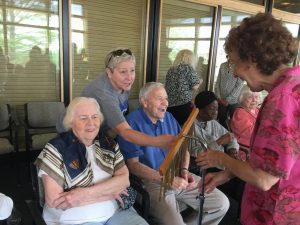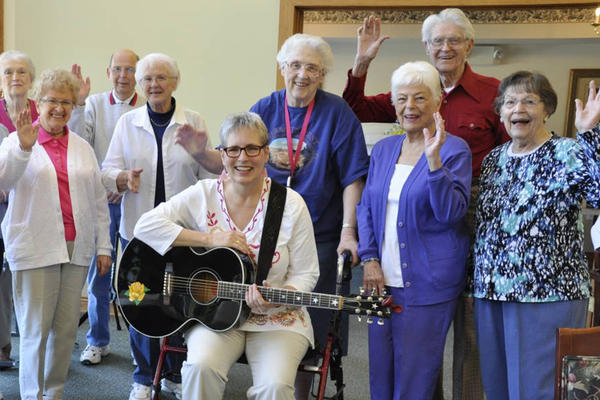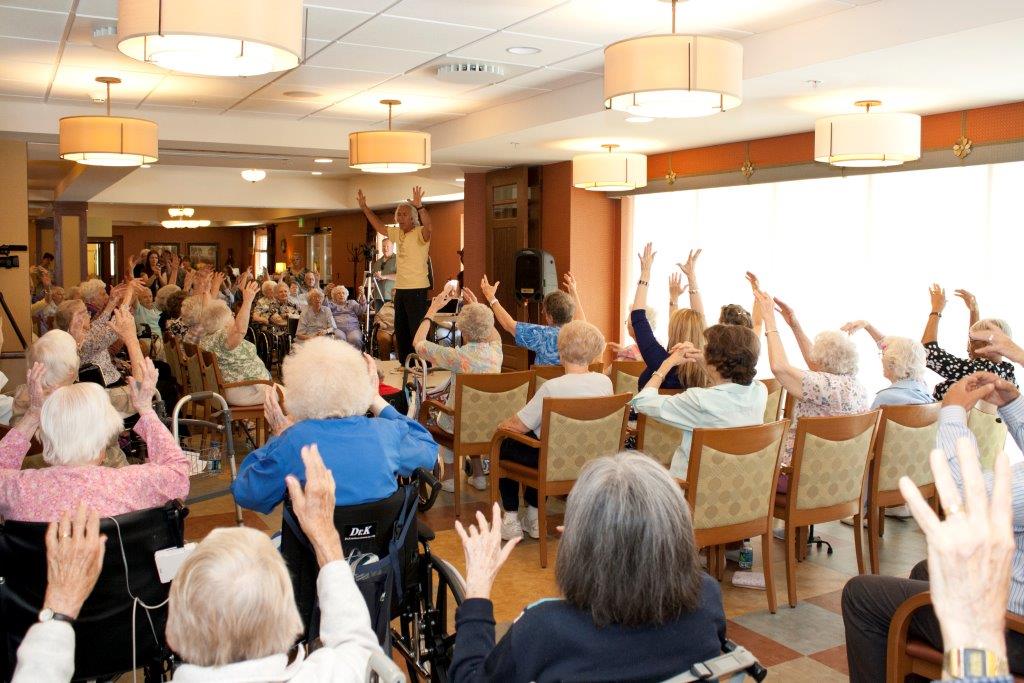Posts Tagged ‘music’
KC Memory Cafe Creates The Sounds of Music: A Visit from the Kansas City Symphony
 If there’s anything more fun than a one-man band, it’s a one-woman orchestra. On May 15, Margaret Halloin graced the cafe with an astonishing array of instruments. She invoked our inner Itzhak when she introduced us to the versatility of the violin. One moment she used a series of chords to transport us to a hoedown; then she built the tension by creating the sounds of of a chase scene. We were mellow with the cello and sliding cool with the trombone. We could all feel the beat as she tapped and shook a variety of percussion instruments. And then, she invited all of us to play
If there’s anything more fun than a one-man band, it’s a one-woman orchestra. On May 15, Margaret Halloin graced the cafe with an astonishing array of instruments. She invoked our inner Itzhak when she introduced us to the versatility of the violin. One moment she used a series of chords to transport us to a hoedown; then she built the tension by creating the sounds of of a chase scene. We were mellow with the cello and sliding cool with the trombone. We could all feel the beat as she tapped and shook a variety of percussion instruments. And then, she invited all of us to play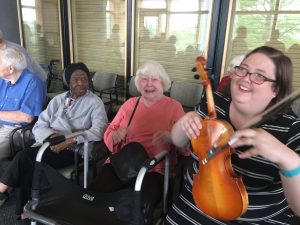 Instantly the room transformed from a quietly listening group of adults to a boisterous band of emerging musicians. One couple beat on a drum together. A woman tentatively held the violin. When Margaret helped her coax a sound of out it, she burst into delighted laughter. People tried the cello, the gong, the bongos, and the French horn. Even better than the sounds of music were the spurts of laughter and the lively conversations. After our chaotic impromptu concert, we gathered in small groups to talk about the music in our lives. One man had been a professional pianist. Several people had played in marching bands. Some had never touched an instrument. Until today.
Instantly the room transformed from a quietly listening group of adults to a boisterous band of emerging musicians. One couple beat on a drum together. A woman tentatively held the violin. When Margaret helped her coax a sound of out it, she burst into delighted laughter. People tried the cello, the gong, the bongos, and the French horn. Even better than the sounds of music were the spurts of laughter and the lively conversations. After our chaotic impromptu concert, we gathered in small groups to talk about the music in our lives. One man had been a professional pianist. Several people had played in marching bands. Some had never touched an instrument. Until today. 
- Invite several musical kids/friends/relatives to come over, tell you about their instrument, and help you make a sound on it.
- Have fun playing imaginary instruments along with a big band or big orchestra music.
- Listen to favorite instrumentals and talk about any memories evoked.
- Look at pictures of various instruments and share stories. Ask open-ended questions with no right or wrong answers, such as, “ What do you think about the piano?” “What are some of your favorite instruments?”
Please join us for our next events:
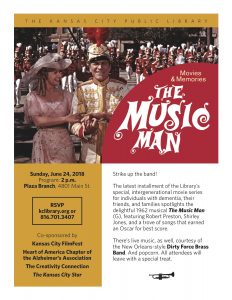
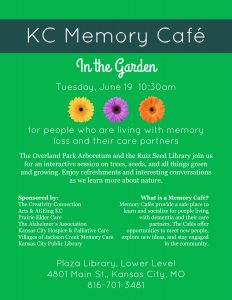

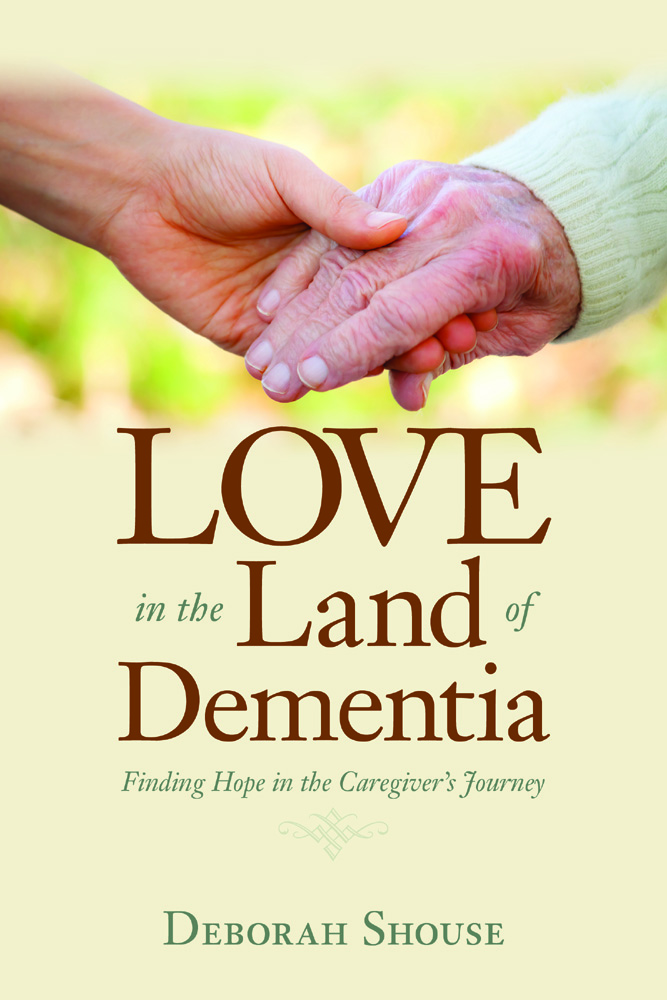
Five Tips for Using Music to Connect
Even as a child, I was using music to connect with my parents. My father was a DJ and my mother enjoyed show tunes and old standards. Those songs often played on our record player and we all enjoyed listening. Later, I used that same music to connect me to my mom and dad during her dementia journey.
Today, I am thrilled to sharing the insights of Mary Sue Wilkinson, Founder of Singing Heart to Heart. Just reading her ideas makes me want to burst into song.
Meaningful Visits: 5 Tips for Using Music to Connect
By: Mary Sue Wilkinson, Founder of Singing Heart to Heart
Let’s face it. Visiting someone with Alzheimer’s or dementia can be hard. You want to connect. You want to make them happy. But things have changed. I understand. I’ve been there. I found a way to connect that I’d like to share with you. Let me explain.
My father in law Virgil had dementia and eventually lost all language. The only thing he could say was “gaba gaba.” His face would light up when I came to visit. I think he knew I was someone he loved. But after the first hug and shared smile…I would flounder. Carrying on a one sided conversation only went so far. I would leave feeling lonely and discouraged. I bet he felt the same. As much as I hate to admit it, I began to put off visiting him.
Virgil had been a Church of the Brethren minister. He knew and loved all the old southern gospel songs. One day I took my guitar and began to play and sing for him. I figured I could at least entertain him for an hour or so. I started singing an old favorite: I’ll Fly Away. Virgil lifted his head, broke into a huge smile and began to sing along. Every word. Perfect pitch. He even added harmony From then on music was the focus of our visits.
It didn’t cure Virgil’s dementia. He couldn’t carry on a conversation with me when the song ended. (Although I have seen this happen with others.) But we connected in a meaningful, joyful activity. This was something we could do together. I began to look forward to our visits. I had learned that we could be together without conversation.
Have you ever hesitated to visit someone with dementia or Alzheimer’s because you were afraid you wouldn’t know what to do or what to talk about? Do you feel like you are losing your connection to your loved one or friend?
Music was the “gift” that allowed me to have meaningful, connected, and happy visits with my father-in-law. I hope that it can do the same for you. Here are some suggestions to get you started.
5 tips for using music when you visit someone with dementia
1. When dementia has progressed to the point where conversations are difficult, or even impossible – turn to music. Singing together and/or listening to music can bring happiness regardless of skill or memory. Remember that you are seeking moments of joy and connection. A shared music experience may or may not elicit shared memories. What it will do, is give you a shared experience, in the moment.
2. Bring music with you to your visit – either holiday music or music popular when they were young. Plan ahead and then share it by saying, “I brought some music I thought we could enjoy together.” If the person you are visiting does not have a CD player in their room, bring one from home, borrow one from the activity director or consider purchasing one as a gift. (You can purchase or download my CD of well known songs here.)
3. If you don’t play recorded music, you can simply sing. Even singing one or two songs will lift spirits – for everyone. It’s a great way to establish a positive mood and communicate that you are someone “good.” Choose well known and simple songs such as You Are My Sunshine, My Bonny Lies Over the Ocean, or I’ve Been Working on the Railroad. Or choose well known holiday songs or songs of faith. These songs often evoke the strongest response from people, bringing a powerful connection. (You can download my free song guides here on my website.)
4. Involve your children or grandchildren in planning a musical visit. Give them the job of figuring out what was popular when your loved one was in their 20’s and 30’s and downloading that music to play during the visit. Let them use their smart phone to make a playlist. Do they have a wireless speaker they could bring along?
If your loved one asks for a song you don’t have ready, simply go to You Tube to find it.
5. Add some energy and fun to your musical time together by patting and clapping to the beat. Don’t hesitate to dance. You may be surprised. Sometimes people can dance better than they can walk. Standing or sitting you can still “dance” together and enjoy a sweet connection.
Remember: “When words fail, music speaks.” (Hans Christian Anderson)
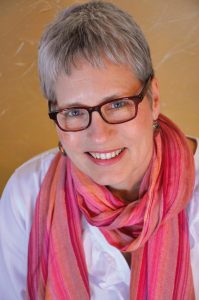 Mary Sue Wilkinson is the founder of Singing Heart to Heart where each year she leads close to 400 singing and music experiences for seniors. She specializes in using music in dementia care. Mary Sue is the author of “Songs You Know By Heart: A Simple Guide for Using Music in Dementia Care” which includes her recording of favorite sing alongs as well as a contribution from Teepa Snow. Learn more and contact Mary Sue at Singing Heart to Heart.com
Mary Sue Wilkinson is the founder of Singing Heart to Heart where each year she leads close to 400 singing and music experiences for seniors. She specializes in using music in dementia care. Mary Sue is the author of “Songs You Know By Heart: A Simple Guide for Using Music in Dementia Care” which includes her recording of favorite sing alongs as well as a contribution from Teepa Snow. Learn more and contact Mary Sue at Singing Heart to Heart.com
Deborah Shouse is the author of Connecting in the Land of Dementia: Creative Activities to Explore Together and Love in the Land of Dementia: Finding Hope in the Caregiver’s Journey.
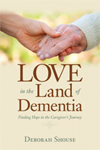

Tuning into Music for Connection: Helping Children Accept Dementia
“Oh what a beautiful morning,” I warbled. My mom clapped and hummed along. At the end of the song, she applauded. In her earlier days of motherhood, she might have winced slightly when I wandered off-key. But in the cradle of dementia, she was delighted with my smile, my energy, and the sheer sound of my voice. And I was delighted to be tuning into music for connection.
Carol Bradley Bursack, an author, speaker, family care partner and creator of Minding Our Elders, recently told me the story of how she helped her teenage children stay connected with their grandfather. I loved her ideas and wanted to share her tips with you.
Tuning into Music for Connection
When he was in his 70s, Carol’s father went into surgery to help repair brain damage from a World War II injury. The doctors expected no issues, but during the operation, something went awry. Her beloved father emerged from the procedure deep in dementia, with a constant voice in his head, and no grasp of reality. Valiantly, Carol dealt with her anger and grief while finding a safe and compassionate care community for her father. Then she began searching out ways she and her sons could stay connected with him.
“Dad loved big band music,” Carol says. “I bought every CD I could find. He loved to direct and listen to the music.”
Finding a Musical Bridge
Carol’s sons were very close to their grandfather. He had always been there for them, a vibrant, fun presence, celebrating their abilities, playing chess with them, and listening to their stories. When her sons saw that Grandfather was so changed he couldn’t even hug them and no longer understood the chessboard, they were devastated.
“They didn’t know how to bond with him,” Carol says.
Carol understood their reluctance to visit and gave them some space. She didn’t make the children feel guilty about their feelings, but she did want them to maintain a relationship with their grandfather. Tuning into music for connection came to the rescue.
The boys both played instruments and Carol urged them to take their clarinet and trumpet to the care community. At first, they were hesitant. They stood shyly before this new grandfather, barely able to blow out the notes. But at the end of their first short tune, Grandfather beamed and asked for an encore. The boys grinned and played more confidently. People came from down the hallways, wanting to hear the music.
“The boys and their music had made a connection,” Carol says. “All three of them were happy and relaxed.”
Creating Together to Build Connection
Carol continued to seek ways to help her sons feel comfortable during their visits. She also wanted them to feel a sense of accomplishment and to cherish their relationship with their grandfather.
Sometimes the boys took hand-drawn pictures to decorate the walls. Other times, they showed up with examples of science projects and told their grandpa about them. The boys brought chess pieces, old photos from Grandpa’s younger days, and games that they’d played with Grandpa. They invited their grandfather to share stories about these objects and often he did.
“It’s hard for young minds to accept such changes,” Carol says. “Their grief can slide under the radar. I was constantly looking for activities we could share, projects that were mutually engaging and that Grandpa could understand.”
Through it all, their mutual love of music kept them together.
For more information on the important work Carol is doing, visit her website: www.mindingourelders.com.
And treat yourself to her book, Minding Our Elders.
Deborah Shouse is the author of Connecting in the Land of Dementia: Creative Activities to Explore Together and Love in the Land of Dementia: Finding Hope in the Caregiver’s Journey.
An Insider’s Look at Connecting with Music
 Encountering fascinating people is always a highlight of our travels. Our recent trip to New York City was dedicated to meeting innovative people in the field of creativity and dementia. I’d interviewed many of these experts for Connecting in the Land of Dementia via telephone or Skype and I was looking forward to learning from them in person. These are the people who are changing the world and who inspire us to go out there and make our part of the world better. In the next months, I’ll be sharing some of their wisdom with you.
Encountering fascinating people is always a highlight of our travels. Our recent trip to New York City was dedicated to meeting innovative people in the field of creativity and dementia. I’d interviewed many of these experts for Connecting in the Land of Dementia via telephone or Skype and I was looking forward to learning from them in person. These are the people who are changing the world and who inspire us to go out there and make our part of the world better. In the next months, I’ll be sharing some of their wisdom with you.
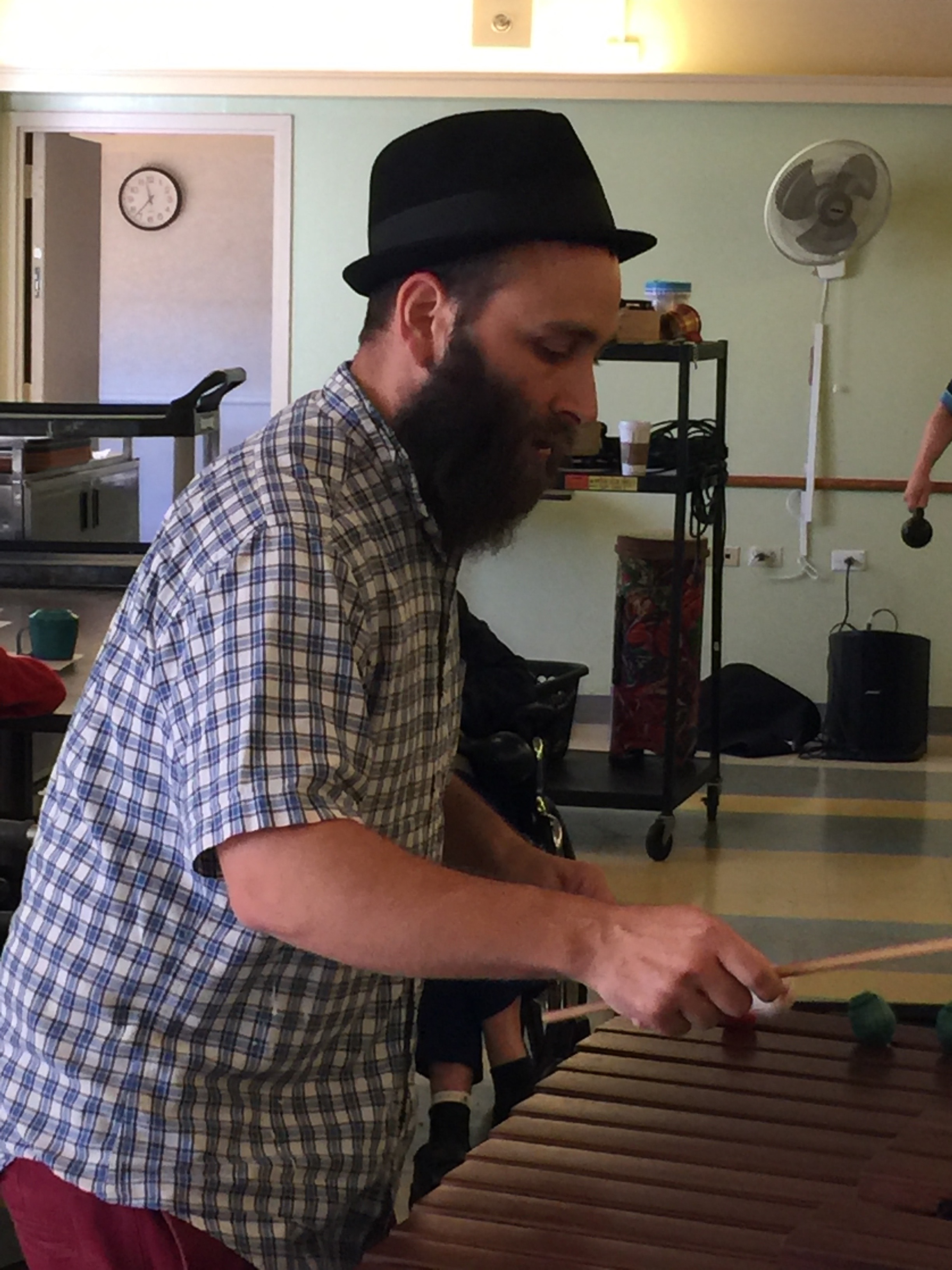 Marlon Sobol grew up with music and understands its universal healing powers. We visited him at a care community in White Plains, NY, where he works as a full-time music therapist. We watched in awe as Marlon worked his carefully orchestrated magic. He started with soothing tones from the marimba, moving into singing everyone’s name as a way of connecting with them. Then he played familiar songs to invite singing along. Finally, he added soundtracks of West African and Caribbean music, which inspired the staff and some of the residents to burst into dancing. In honor of our visit, Marlon played and sang, “Going to Kansas City,” which made us leap out of our chairs, sing along and dance.
Marlon Sobol grew up with music and understands its universal healing powers. We visited him at a care community in White Plains, NY, where he works as a full-time music therapist. We watched in awe as Marlon worked his carefully orchestrated magic. He started with soothing tones from the marimba, moving into singing everyone’s name as a way of connecting with them. Then he played familiar songs to invite singing along. Finally, he added soundtracks of West African and Caribbean music, which inspired the staff and some of the residents to burst into dancing. In honor of our visit, Marlon played and sang, “Going to Kansas City,” which made us leap out of our chairs, sing along and dance.
Here is a tip from Marlon:
“Our names are so important. Music is a way to help people stay connected with their names. I often sing a name as a way of engaging. You can add a name to any simple tune and invite people living with dementia to sing along.”
Click on these shorts videos for other ways to incorporate music and movement into your everyday life.
The power of music and movement
Read more about Marlon’s programs in Connecting in the Land of Dementia: Creative Activities to Explore Together. Order your copy from your favorite independent or online bookstore.
Three Top Tips for Tuning into Singing: Insights from Finland
Mom was staring into space, oblivious to my brilliant smiles and cheerful conversation. So I started to sing, just to occupy myself. I chose songs Mom liked, such as “Oh What a Beautiful Morning,” “A Summer Place,” and “You are My Sunshine.” Normally, I felt a little down when I didn’t really get to connect with Mom during my visits. But after a half-hour of being a one-woman show, I felt uplifted and energized. And Mom seemed to be making a sound much like humming.
Singing was often a part of my time with Mom. I’ve always felt happy after “making a joyful noise.” Now a study from Dr. Teppo Sarkamo and his colleagues in Helsinki, Finland, explains why.
Dr. Sarkamo’s research found that “regular musical activities can have an important role in maintaining cognitive ability, enhancing mood and quality of life” for people living with mild to moderate dementia. These activities also promote the well being of care partners and offer a beneficial leisure activity for the person living with dementia and the care partner.
Invite Out Your Inner “American Idol”
You don’t need special musical abilities to benefit from listening to music or singing. The research shows that incorporating simple musical activities in daily care is “a cost-efficient way for offering emotionally, cognitively stimulating, and enriching musical experiences.”
The study’s music therapist, Sari Laitinen, kindly offered these ideas for care partners and the person living with dementia.
- First, reserve enough time together to spend with the music. The main thing is feeling peaceful together. When singing, choose the songs together from a songbook. In our research project, we prepared a song booklet of our own for the participants, which mostly included well-known Finnish singe-a-long songs from their early years: childhood, teenage years and early adulthood. The care partner can begin by humming a melody first, and if their partner recognizes the song, they can start singing it together. Usually, the partner knows the lyrics “by heart” and their memory retrieval is quite automatic.
- Usually the songs bring about personal, autobiographical memories related to the life era and events when the songs were popular. Allow the reminiscence of your partner to proceed on its own time and terms, accepting the stories and not immediately correcting if the people or places happen to be incorrect. You want a mutual feeling of telling each other important things about life. It is all about acceptance and the understanding that something important is shared. The feeling of being understood helps to cope with life.
- Listening to music is based on the same principles as singing together: the care partner can suggest some records he/she thinks are meaningful and see what happens. When asking your partner to choose the record, it is good to have some LPs or CDs with a photo of the artist on the cover. Again, it is nice to have a quiet place for the listening and time to share the stories and the feelings that the music evokes. It is good to keep in mind that although the songs are familiar from a long time ago, the experience of music is always “here and now”. By experiencing the music together and by being sensitive to the ”reactions” (emotions, thoughts, memories) evoked by the music, the care partner can offer acceptance and validation of the experiences, the feeling of being understood. Given time, this can lead the discussion from the reminiscence of old times to themes that are important now, such as acceptance of the lived life, mourning of losses, joy in the moment, feeling of vitality, strengthening the feeling of life and so on.
For more information, visit: Singing is beneficial for memory and mood especially in early dementia
Clinical and Demographic Factors Associated with the Cognitive and Emotional Efficacy of Regular Musical Activities in Dementia, Teppo Sarkamo, Sari Laitinenb, Ava Numminenc, Merja Kurkib, Julene K. Johnson, and Pekka Rantanene a,
Music Matters in the Land of Dementia
How can creating a personal playlist, listening to favorite tunes, singing simple melodies, and pretending to conduct a symphony improve your life? Come to this free workshop and find out.
Music Matters in the Land of Dementia (and Everywhere!) An Interactive Program for Family Friends, Professional Care Partners, Activity Professionals, Musicians, and More
 In this lively one-hour session, coming up on July 20, we will share ideas for using music to deepen connections with people who are living with dementia. Some of these ideas, gleaned from top innovators and researchers, are from my upcoming book, Connecting in the Land of Dementia: Creative Activities to Explore Together. According to numerous studies, music improves the lives of those living with dementia by reducing the need for psychotropic drugs, increasing socialization, and relieving depression. The event is going to be joyful and fun and we’d love to experience it with you.
In this lively one-hour session, coming up on July 20, we will share ideas for using music to deepen connections with people who are living with dementia. Some of these ideas, gleaned from top innovators and researchers, are from my upcoming book, Connecting in the Land of Dementia: Creative Activities to Explore Together. According to numerous studies, music improves the lives of those living with dementia by reducing the need for psychotropic drugs, increasing socialization, and relieving depression. The event is going to be joyful and fun and we’d love to experience it with you.
Here’s the workshop information:
Deepen your connections, increase communications, and ratchet up your fun quotient by adding music into your caregiving journey. Authors and dementia advocates Ron Zoglin and Deborah Shouse team up with guitarist Rod Fleeman and singer Cynthia Schroer for this hands-on session. They’ll share easy music-oriented ideas that can soothe anxieties and unlock creativity in people who are living with dementia, as well as splash notes of joy and renewal into the care partners’ lives.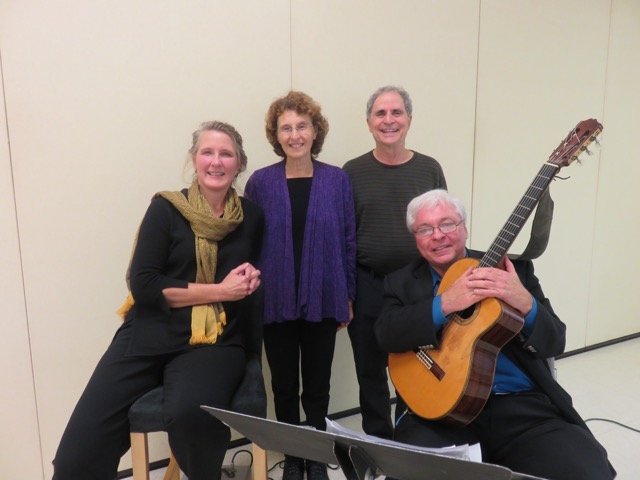
We are partnering with Shalom University to present this free session on July 20th from 10:00 to 11:00 at Village Shalom, at corner of 123rd and Nall, 5500 W 123rd Street, OP 66209. To sign up for this musical experience, just call Bree at (913) 266-8469 or email vsu@villageshalom.org as soon as possible.
Victor Hugo said it so beautifully: Music expresses that which cannot be put into words and that which cannot remain silent.
Music Matters
 During my mom’s dementia journey, music often inspired and connected us. Here is one of those melodic moments, excerpted from my book, Love in the land of Dementia: Finding Hope in the Caregiver’s Journey. The story is set in my mom’s memory care community.
During my mom’s dementia journey, music often inspired and connected us. Here is one of those melodic moments, excerpted from my book, Love in the land of Dementia: Finding Hope in the Caregiver’s Journey. The story is set in my mom’s memory care community.
Rochelle, the activity director, sticks in another tape and soon Stardust is playing.
“Let’s dance,” she says, motioning everyone to stand.
Mom looks up and I offer her my hand.
“Want to dance?” I ask her.
“What?”
“Want to dance?” I repeat, making a swirling motion.
“What else,” she says, standing up.
My parents have danced to this song many times, my mother coaxing my father onto the dance floor. I hold hands with Mom and move back and forth to the music. She laughs and does the same. I twirl her, and she walks around in a jaunty little circle. For a moment, her energy and charm have returned. I feel like I have found my long-lost mother. If my father were here, he would not be surprised. He is certain she will return to him and takes every word, every gesture of affection, every smile as a sign of hope.
“Hope is everything,” Dad told me just last week. “I find something hopeful and I milk it for all it’s worth. If it doesn’t work out, then I search for something else. Otherwise, I am in despair.”
I twirl my mom again. It is actually our first real dance together…
Deborah Shouse is the author of Love in the Land of Dementia: Finding Hope in the Caregiver’s Journey.
COMING SOON: CONNECTING IN THE LAND OF DEMENTIA: CREATIVE ACTIVITIES TO EXPLORE TOGETHER
Strengthen your Heart, Open Your Ears, and Ignite your Spirit with Conductorcise
Maestro David Dworkin moves his baton and a Strauss waltz begins. But instead of facing a sea of symphonic musicians, the auditorium is filled with people also holding batons, following the Maestro’s movements. They are engaged in the Maestro’s globally renowned exercise program, Conductorcise.
Click here for an exhilarating example: Conductorcise
As the music continues, two women begin to waltz in the aisle. Later, he learns that these women are living with dementia. “They haven’t moved in months,” a health care worker tells him.
At a memory care unit, he passes out batons, handing them even to people who seem slumped and unresponsive. He introduces John Phillip Sousa, offering a few tidbits about the composer. Then he starts a Sousa march and leads his group in vibrant upper body movements. Soon everyone, even three people who seemed oblivious, are conducting along with him.
Such is the power of movement and music.
Leading with Benefits
“The vibrations and energy of the music speak to people,” says Masetro Dworkin. “You benefit from relieving stress, building aerobic stamina, improving listening skills, and increasing social engagement while imagining yourself leading a symphony orchestra.”
As a bonus, you can learn a little about the lives and works of the great composers.
The program appeals to all ages and abilities and has spread around the world, from Holland to Canada to Singapore.
Conducting for Two or More
The program works wonderfully one-on-one.
“You can’t do anything wrong,” Maestro says. “You don’t even need a baton. You can use chopsticks, unsharpened pencils, a straw, or just your arms.”
Here are a few tips for enjoying Conductorcise:
- To get started, you might say, “How about helping me conduct this tune?”
- Select a familiar song your partner enjoys, one that might also inspire conversation and singing.
- Move your arms and upper body to the music and encourage your partner to move as she wishes. Move your lower body as well, if appropriate.
- For those who need extra support, add eye contact and gently stroke their arms.
- Invite friends and family members to join you.
“Everyone wants to be a conductor!” Maestro Dworkin says.
###
Visit http://www.conductorcise.com glean ideas from Maestro’s listening library and information about his training and certification programs.
Julliard-trained Maestro David Dworkin has led orchestras across the globe, and performed as clarinetist with ensembles internationally. He served as conductor and Artistic Consultant for three PBS Television documentaries in the series Grow Old With Me, and devoted much of his career to working with young people. In his 80’s, he has become a sought-after role model for all, demonstrating how exercise, music, joy and a positive outlook can create a healthy journey through life.
Deborah Shouse is the author of Love in the Land of Dementia: Finding Hope in the Caregiver’s Journey.
Creating a Real Hit: Building Community Through Drumming
Life is about rhythm. We vibrate; our hearts are pumping blood; we are a rhythm machine; that’s what we are. – Mickey Hart
Some might have thought it a hassle to be hauling such a large load of percussion instruments, but Renee Kessler didn’t mind. She was thinking of the sudden smile she’d see when her mother-in-law began rhythmically shaking the maracas. Or the joy she’d see in Mr. Norman’s eyes as he beat the drums. She was glad to see the circle of residents in the memory care unit waiting for her and relished offering them choices of bells, clappers, triangles, drums, tambourines, and rain sticks.
“Through our drumming circles, we give people choices, we inspire them and we wake them up. Their eyes brighten when we play music,” Renee says.
Renee has a long history of waking people up through engaging them in creative arts. She worked as a teacher for an esteemed arts school in West Palm Beach, Florida, and now serves as a consultant, helping students prepare for arts programs. And she’s long been involved as a family care partner. When a drummer friend invited her to visit memory care units with him, she was eager to go; she’d been collecting instruments for years.
The experience was meaningful for all involved. Once they talked to each participant and distributed the instruments, the drummer set a beat and gradually everyone chimed in.
“We kept the flow of the energy and then we stopped and invited people to make random noise,” Renee says. “People were very expressive and eager to beat on drums, flap the clappers, and shake bells.”
Being part of rhythm and music energized and equalized everyone and built a sense of community, creativity, and connection.
Want to create connection through percussion instruments?
- Set the tone with a drumbeat or select a CD of familiar music with a definite beat.
- Offer a choice of noisemakers. If needed, you can beat a pen on a book or put some beans in a jar to make an impromptu shaker. Or you can hit two spoons together.
- Encourage your loved one to make as much noise as possible. Do the same. There’s liberation in making noise and there’s a sense of connection sharing the same rhythm.
Deborah Shouse is the author of Love in the Land of Dementia: Finding Hope in the Caregiver’s Journey.
Appreciating Who We Are
A man who is living with Alzheimer’s strides onto the stage and people applaud wildly. His son leans across the drums and hands him his guitar. His daughter, poised on the banjo, subtly reminds the man to look at the monitor so he can remember the words to the songs.
Everyone on stage is tuned into making the performance a great experience for the man and everyone in the audience is eager to hear from him. “So what if he sings Rhinestone Cowboy twice,” says one fan.
This scene is a snippet from Glen Campbell’s documentary, “I’ll Be Me.” As I watched Glen connect through his familiar music and bask in the support of his family and fans, I wished that every person could be so supported and celebrated, particularly those who are living with dementia.
As we approach Valentine’s Day, I wanted to share this essay about appreciating each of us for who we are. For me, it’s a reminder to celebrate love and the creative spirit in all their glorious guises.
Please Take a Bow
By Deborah Shouse
The stage thrilled with activities. One man juggled 12 balls. From overhead, a woman floated down on streamers of royal blue fabric, and then wound herself back up to the arena ceiling. Lithe performers dressed as jungle animals danced and tumbled. I sat in the audience, awed by the amazing creativity of Cirque de Soleil. I hardly knew where to look, so much was going on. But one performer consistently drew my attention. A woman dressed as a wood nymph walked around pointing to whichever feat she most admired. As a man juggled dangerously long sticks, the nymph held out her arms toward him, her gesture saying, “Ta da, Look at this!”
The singer burst into an acrobatic aria and the wood nymph ran towards her, unfurling her arms in another “Ta Da” gesture, focusing our attention and directing our applause. One act after another somersaulted, soared and danced and the wood nymph was always there to shine extra attention on them.
Afterwards, I stood in the corridors with Ron and our friends, Jacqueline and Michael, talking over favorite parts of the show.
“I really liked the wood nymph,” I told Jacqueline. “We should take turns doing that for each other.”
She agreed. But then we both wondered, what would we applaud? Jacqueline and I did our writing work practically immobilized in front of the computer. Michael was a legal aid attorney and Ron had an antique shop. The last time any of us had even somersaulted was eons ago, in our firefly laden summertime back yards. Yes, we juggled, but it was the usual middle class shticks, wildly tossing around work, family, exercise, community, friends and more. All the more reason, I thought, to find an appreciator who understood when we performed at our personal peak.
As we discussed the amazing acrobatic skills we had just seen, I imagined going over to Jacqueline’s. There she sits at her dining room table, her computer screen bright, her fingers nimble. She is a great writer and she is working her craft. I stand nearby, face the imaginary audience seated in her living room, and hold out my arms, gesturing proudly towards Jacqueline. She smiles shyly and I hold my appreciative pose. Then Michael walks through on his way to the kitchen.
“Hi Deborah, what are you up to?” he says.
I nod towards Jacqueline, who is writing briskly, and unfurl my arms towards her.
“Oh, yes, I see,” Michael says. He applauds. Jacqueline sits up straighter and allows herself a little bow. A lot of people don’t understand what hard work writing is and I am here to make sure her audience appreciates the subtlety and strength of this art form. Suddenly, Jacqueline stops. I imagine a drum roll as she presses her lips together, furrows her brow and stares into space. She is trying to think of the right word. We all know how hard that is–it’s the equivalent of the back flip followed by the double mid-air somersault. She shakes her head in despair. The audience is on the edges of its seats, mouths agape, hearts racing. Will Jacqueline find the word? Or will she crash to the ground, her sentence in shambles, her paragraphs paralyzed?
Finally, Jacqueline grins and returns to the keyboard, her fingers dancing. I point to her—“TaDa”– and her audience erupts into applause.
Meanwhile, while I daydreamed, the Cirque de Soleil arena was emptying. We walked to our cars and the image of the wood nymph stayed with me all the way home.
As Ron and I walked toward our house, I remembered a conversation we’d had several weeks ago. “Why don’t you ever mention how great the yard looks?” he’d said. “I’ve worked hard on creating this.”
I had started to defend myself. Then I realized he was right. I liked the yard but its lushness was part of my normal world, the world I rushed blindly past. I hadn’t taken time to appreciate all the effort Ron had put into creating it.
Now I stopped on the sidewalk. The porch light illuminated the plants and ivy as I swept my arms toward the yard, then back to Ron.
“Ta da!” I said, pointing to his lawn, then applauding him. He stared at me, and then smiled.
“Thank you,” he said. “Thank you for noticing.” He took a bow.
I followed him as he left the stage and went into the house.
Deborah Shouse is the author of Love in the Land of Dementia: Finding Hope in the Caregiver’s Journey.
Singing Along, Singing Our Song and Making a Difference
“What’s the score?”
Thet was the question on all of our minds Wedsnesday evening October 15 as the KC Royals played the fourth playoff game with the Baltimore Orioles. For months, we’d been scheduled to present an Alzheimer’s program at this church, A Music Lesson in the Art of Love, with singer Cynthia Schroer and guitarist Rod Fleeman. But our baseball team’s wild, wonderful, and unexpected success was taking precedence that evening.
The preacher looked at his cell phone.
“The score is 2-1 KC in the bottom of the ninth,” the preacher said.”We are two outs away from being in the World Series.”
All 20 of us crowded closer and the preacher gave us a play-by-play of the proceedings. When the Royals won, we all cheered and applauded and Rod led us in a rousing version of Take Me Out to the Ballgame.
After our jubilation abated, we settled in to do our program, a combination of songs and stories that focused on the gifts and blessings in the caregiver’s journey.
Cynthia and Rod are remarkable musicians and I wanted to share one of their songs with you. Click here to listen.
I also wanted to share an article about three people who are really making a difference using music. This article from Unity Magazine features the inspiring stories of Dan Cohen from Music and Memory, Janalea Hoffman from Rhythmic Medicine, and Richard Mekdici from Posi Music. Click here to tune into it.
Here’s to singing along, singing our song, and making a difference.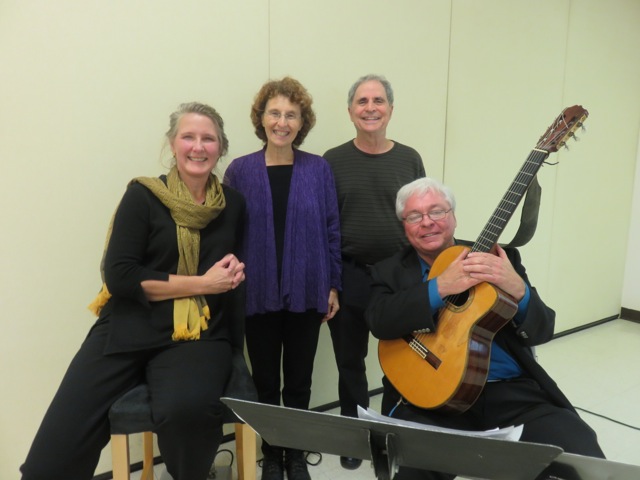
Deborah Shouse is the author of Love in the Land of Dementia: Finding Hope in the Caregiver’s Journey.

